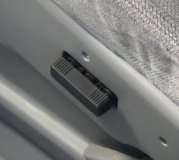Hi and thanks for using 2CarPros. Com.
If fuses are good and you checked wiring, is there power to the unit?
Here are the test procedures from Alldata for you to look through. Take a look and let me know if anything helps.
__________________________
ELECTRONIC VEHICLE INFORMATION CENTER
The Electronic Vehicle Information Center (EVIC) data is obtained from several components on the Controller Area Network (CAN) Data Bus circuit. The EVIC will not function properly if the bus messages from any of these components is not received. If no EVIC data is displayed, check the CAN Data Bus circuit communications, the Instrument Cluster (also known as Cab Compartment Node (CCN)) functions and the Totally Integrated Power Module (TIPM).
If the problem with the EVIC is an inaccurate or scrambled display, refer to SELF- DIAGNOSTIC TEST. If the problem with the EVIC is incorrect Vacuum Fluorescent Display (VFD) dimming levels, use a scan tool and the proper Diagnostic Procedures Information to test for the correct dimming message inputs being received from the CCN or TIPM over the CAN data bus circuit. If the problem is a no-display condition, use the following procedure.
For complete circuit diagrams, refer to the appropriate wiring information. The wiring information includes wiring diagrams, proper wire and connector repair procedures, details of wire harness routing and retention, connector pin-out information and location views for the various wire harness connectors, splices and grounds.
1. Remove the overhead console from the headliner See: Console > Removal and Replacement > Removal.
2. Inspect the Ignition Off Draw (IOD) fuse in the TIPM. If the IOD fuse is OK and in place, go to STEP 3. If not OK, repair the open IOD fuse circuit as required.
3. Check for battery voltage at the overhead console electrical connector. If OK, go to STEP 4. If not OK, Check for battery voltage at the appropriate B(+) fuse in the TIPM, repair the open fused B(+) circuit as required.
4. Turn the ignition switch to the On position. Check the fused ignition switch output circuit(s) at the overhead console electrical connector. If OK, go to STEP 5. If not OK, repair the open or shorted circuit as required.
5. Turn the ignition switch to the Off position. Disconnect and isolate the battery negative cable. Check for continuity between the ground circuit cavity of the overhead console electrical connector and a good ground. There should be continuity. If OK, refer to SELF- DIAGNOSTIC TEST for further diagnosis of the EVIC module and the CAN data bus circuit. If not OK, repair the open ground circuit as required.
SELF- DIAGNOSTIC TEST
NOTE: The EVIC self - test can also be performed using a scan tool. Navigate to the Auto Self Test screen under System Tests of the scan tool and initiate the EVIC self - test.
A self-diagnostic test is used to determine that the EVIC is operating properly electrically. Initiate the self-diagnostic test as follows:
1. With the ignition switch in the Off position, simultaneously depress and hold the STEP and RESET buttons while rotating the ignition switch to the Run/On position.
2. Continue to hold both buttons depressed until the EVIC enters the display segment test. In this test, all of the Vacuum Fluorescent Display (VFD) segments are lighted while the EVIC performs the following checks:
- Non-Volatile Memory Status (NVM)
- RAM Status
- ROM Status
- ASIC Communication Status
- Compass Status
- DC Status
- CAN Data Bus Communications Status
NOTE: If the EVIC module is equipped with the Universal Transmitter (also known as HomeLink(R)), the module also checks "HomeLink(R) Communication Test Status".
3. Following completion of these tests, the EVIC will display one of two messages: "Self Test: FAIL" or "Self Test: PASS." In addition to the FAIL/PASS message the EVIC will display the current software version (SW V xx. Xx. Xxx) below the FAIL/PASS info. Press the RESET or STEP button to exit and enter normal mode. Respond to these test results as follows:
- If no test result message is displayed, but EVIC operation is still improper, the use of a scan tool and the proper Diagnostic Procedures Information are required for further diagnosis.
- If the "Self Test: FAIL" message is displayed, the EVIC is inoperative and must be replaced.
- If the "Self Test: PASS" message is displayed, the EVIC is OK, no faults are present.
- If any VFD segment does not light during the display segment test, the EVIC is inoperative and must be replaced.
If the first seven tests pass, the EVIC shall verify that all the required CAN bus messages are present on the CAN bus. If all required messages are present on the CAN bus, the EVIC will automatically return to normal operation after sixty seconds. The EVIC can also be returned to normal operation any time during the test by pressing the STEP, C/T, RESET or US/M buttons.
NOTE: Pressing the STEP or RESET buttons during any portion of the EVIC Self - Diagnostic Test Procedure will cause the EVIC to exit diagnostics and return to compass/temperature mode.
NOTE: If the compass functions, but accuracy is suspect, it may be necessary to perform a variance adjustment. This procedure allows the compass unit to accommodate variations in the earth's magnetic field strength, based on geographic location.
NOTE: If the compass reading has blanked out, and only "CAL" appears in the display, demagnetizing may be necessary to remove excessive residual magnetic fields from the vehicle. Check for stored Diagnostic Trouble Codes (DTCs) and follow the proper Diagnostic Procedures Information as needed.
___________________________
Let me know what you find.
Take care,
Joe
Monday, November 12th, 2018 AT 5:52 PM


